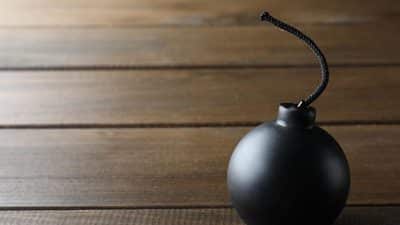Story by Zach Pereles

It was the most revealing pair of games Virginia has played this season, a perfect way to measure where the team sits as it hits the final portion of the regular season.
Here are some big takeaways from the past two games:
Ty Jerome might not be 100 percent, but he’s played like he is.
Leading into Virginia’s game against Duke, the Cavaliers didn’t announce whether Ty Jerome would be available until he was on the floor for opening tip. It made sense for Virginia to not show its hand regarding Jerome’s status, but Jerome himself is much more open about his sprained back.
“I’ll be sore as ever going back home tonight,” Jerome said after the win over North Carolina.
Jerome didn’t warm up with the team Monday, instead electing to stretch and use a heat pack in the locker room. Medicine, “Icy Hot” and adrenaline allowed him to make it through 37 grueling minutes. As ESPN cameras showed, he didn’t even sit with the team during timeouts, opting for the padded sideline seats over the fold-out chairs.
It wouldn’t be fair to say Jerome has carried the team on his back — he hasn’t — but he’s definitely done some heavy lifting. Jerome scored 16 against Duke, tied for the team high. Then he scored 15 more and added 11 assists against North Carolina, his second double-double of the season. Considering the Cavaliers only made 24 shots Monday, 11 assists is an incredibly impressive number.
“Fifteen points, 11 assists and two turnovers,” Tony Bennett said. “That says a lot. The way they pressured us, we had to take care of the ball and touch the paint and then make the right play. Sometimes it was the shot, but usually with the way they pressured and converged, was to kick it out. He was really good once he got settled in. … He’s tough. He is a warrior and I love how he stepped up and made the big plays. They all did down the stretch.”
Jerome posted an offensive rating of 141, somehow only his third-best mark in ACC play (behind Notre Dame and Virginia Tech).
The progress Jerome has shown across the board this year is impressive. His offensive rating of 119.5 in is nearly 10 higher than it was last year, and he’s shooting better from two and from three than he did last year.
But it’s not just the numbers that are so important. Jerome is a masterfully composed player late in the shot clock. Take, for example, his action with just over four minutes to play Monday. With time running down on the shot clock, Jerome drew a switch and found himself up against North Carolina big man Garrison Brooks. Jerome immediately recognized that he had the advantage on the perimeter and drew a foul on the big man with just three seconds left before the shot clock expired. The shot clock reset to 20, and De’Andre Hunter scored moments later.
Jerome continues to show why he’s the vital cog that can make Virginia operate at its best. When he’s on top of his game, the Cavaliers can play with anyone — and throttle almost everyone.
These Cavaliers are tough.
Virginia could have gone away in both of the past two games. Duke wasn’t supposed to be able to hit nearly 62 percent of its three-pointers. UNC wasn’t supposed to be able to speed the Cavaliers up. Yet both of those opponents did what they weren’t supposed to be able to do. Still, the Cavaliers weathered the storm and hung in there when most teams would have seen those events as knockout punches.
Let’s start with Duke. The Blue Devils knocked down 13 of their 21 threes, their best percentage in a single game since 2015. Considering it’s been nearly four years since a Duke team shot the ball that well, and combined with the immense skill set of Duke’s top three players, that should have been a death sentence. Instead, Virginia hung in there. Even though the Cavaliers played far from their best, they kept the game relatively close until the final minutes. That’s not to say UVA should necessarily be proud in a loss, but most teams would have been absolutely blown out in such a setting.
Duke has hit double-digit threes this year on seven other occasions this year, and its average margin of victory in those games is 31.6. That includes a season-opening 34-point beatdown of Kentucky, a team which has turned out just fine. Credit UVA for keeping its contest with Duke to within single digits nearly the whole way.
North Carolina provided a different challenge. The Cavaliers looked completely out of sync for the opening part of the second half. Back-to-back losses looked a certainty. Then Kyle Guy got going. So did Ty Jerome. But more importantly, so did the defense. North Carolina scored just six points over the final seven minutes after scoring 26 in the 13 minutes prior. This isn’t Tony Bennett’s best defensive team. It doesn’t have a big, strong lockdown guard like Devon Hall or an ACC Defensive Player of the Year like Isaiah Wilkins. But when the Cavaliers needed it most Monday, they showed they can still clamp down on an opposing offense like very few other teams can.
“We’re gritty; we’re tough,” Jerome said. “Guys made big plays. We got big stops. Guys did a great job of getting big rebounds on the glass. We’re just a gritty, tough team, and we have to continue to play like this moving forward.”
Turnovers are becoming an issue…
The Cavaliers turned it over 10 times Monday, the fourth consecutive game in which they have registered double-digit turnovers. Normally so good in that area, Virginia is wasting an usually large number of possessions by throwing the ball away. Some of that has been due to the opponent. NC St. and Duke are among the top 50 in college basketball in turnover percentage forced, and Miami and UNC are in the top half in the nation.
Still, that doesn’t really excuse how often Virginia is giving the ball away, especially on live-ball turnovers that opponents can take the other way. The Cavaliers have struggled when opponents extend their defense, whether via a press or just a higher-intensity halfcourt look. There’s blame to go around. Against UNC, seven of the eight players who saw the court had at least one turnover, and two were charged as team turnovers. UNC turned that into 13 points. With some extended time off between now and Saturday’s matchup with Notre Dame, Virginia will likely look at what’s gone wrong in the turnover department and how it can better deal with opponents’ pressure.
… as are offensive rebounds.
This one, again, is partially a product of opponents’ strengths. Duke ranks fifth in offensive rebounding percentage and North Carolina is eighth. There’s a good chance UVA won’t see a better offensive rebounding team than the two teams it just played.
Still, this is quickly becoming an issue that wasn’t ever expected to be one. NC State, Duke and UNC all grabbed at least 36 percent of its misses. Virginia has slipped all the way to 52nd in defensive rebounding percentage. Over the last two games, opponents have attempted 53 threes against Virginia, which is naturally going to lead to a few more long rebounds and, hence, a few more offensive boards. But, like the turnovers, there is blame to go around. Virginia’s big men have sometimes been late to recover in a switch, and sometimes guards have resorted to just flowing to the loose ball instead of actually boxing out their assignment.
In rebounding more so than in any other part of the game, a split second of indecision or hesitancy can cost a team in a big way. One example of this against was when Tar Heels forward Cameron Johnson caught a wide open pass near the basket. Mamadi Diakite scrambled over at the last second and Johnson missed the easy basket, perhaps intimidated by an incoming Diakite. But all the other Cavaliers seemingly stopped playing and just assumed Johnson would make the layup. When he missed, he grabbed an uncontested offensive board and was fouled. If any of the surrounding Virginia players had simply moved toward the ball, the Cavaliers wouldn’t have allowed Johnson a second shot at it.
Minor takeaways:
De’Andre Hunter has only taken 19 shots in the past two games as teams have really keyed on him. But credit him for being extremely efficient in the UNC game, scoring 20 points on just 10 field goal attempts. There are times when it seems like he could be a bit more aggressive looking for his own shot, but he also knows that when Virginia needs a bucket most, he’s the one that can deliver. He scored a tough layup to even things at 59 and then when UNC tried to come over and help on his next drive, he delivered a perfect assist to Jay Huff that gave Virginia the lead for good.
I wrote about Virginia’s big man rotation a few weeks ago. That was when Jay Huff was coming off his big performance down the stretch against NC State and Diakite had become the go-to defender for quicker, more skilled opposing big men. Against UNC, Diakite led the way with 23 minutes, Salt played just 10, and Huff played eight. But Huff was the man down the stretch as Virginia mounted its comeback and eventually took the lead. The Cavaliers outscored the Tar Heels by eight in Huff’s eight minutes.
That’s obviously not a perfect measurement of a player’s effectiveness. Just because Ty Jerome and Kyle Guy start knocking down shots when Huff is in the game doesn’t necessarily mean they wouldn’t have made them with one of the other big men in there. But it is worth noting Huff leads all rotation players in “box plus-minus,” a stat that tries to estimate how much better/worse a player makes his team against an opponent over the span of 100 possessions.
(Of course, Huff’s 13.5 box plus-minus is nowhere near matching superstar walk-on Grant Kersey, whose 28.1 box plus minus is tops in the nation among players who have played at least four minutes. But that’s a discussion for another day.)
Kihei Clark does a ton of really good things. He’s an outstanding perimeter defender, as Coby White’s 6-for-19 shooting performance shows. But when North Carolina extended its press, Clark really struggled, and Bennett was forced to take him out of the lineup. Clark subbed out with 11:32 remaining and did not get back in the game. Credit De’Andre Hunter, mainly, for continuing the tough defense on White.
Finally, the entire complexion of this offense changes when Kyle Guy gets on track. When he’s hitting shots, Virginia’s already-tough offense becomes even more difficult to stop. If opponents commit too heavily to him, he has shown a much-improved ability to find the open teammate. Guy is averaging a career-high 2.1 assists this year.










